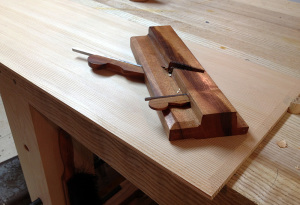Specialty Hand Tools
Lately there is a movement towards smaller tool kits. I think this message speaks to the “anarchist” in all of us and certainly the smaller tool kit is easier on the wallet and doesn’t take up much space in a tiny shop. I’m a big fan of this dogma mostly for the skills that it engenders. I even published a Hand Tool School lesson discussing a “Road Tool Kit” that contains less than 15 tools and fits in a small tool tote (a la Roy Underhill). Having fewer tools that do more builds a strong fundamental skill set. When you don’t have a specialty tool to accomplish a task you can always fall back on the lowly chisel to do the job. This simple tool kit is so powerful and your skills will grow to match it. Now that being said, we live in a glorious renaissance of hand tools where the market is awash with quality tools made by boutique and mid size manufacturers alike. Specialty hand tools are everywhere and I am not immune to their charms. Do I think it is important to know how to accomplish a task using a fundamental tool? Of course. Do I quickly forget that mantra and succumb to the lusty siren call of the specialty tool? I’m only human.
 I have a few of these one hit wonders and picking a favorite is hard because once one of these beauties has made your life easier it becomes the favorite…until another one takes its place by doing the same thing. For today, my Mini Panel Raiser by Phil Edwards of Philly Planes is the winner. This petite oddity made from Goncalo Alves (Tigerwood to the decking world) does one job and it does it like a champ: it cuts a tapered shoulder allowing your panels to fit snugly into any groove. The diminutive size and cutting width (just over an inch) makes this plane perfect for drawer bottoms or interior panels though the raised profile is attractive enough to use it on a show face panel for smaller doors and cases. I actually have a full size panel raiser by Phil too and I’ll talk about that in a future post.
I have a few of these one hit wonders and picking a favorite is hard because once one of these beauties has made your life easier it becomes the favorite…until another one takes its place by doing the same thing. For today, my Mini Panel Raiser by Phil Edwards of Philly Planes is the winner. This petite oddity made from Goncalo Alves (Tigerwood to the decking world) does one job and it does it like a champ: it cuts a tapered shoulder allowing your panels to fit snugly into any groove. The diminutive size and cutting width (just over an inch) makes this plane perfect for drawer bottoms or interior panels though the raised profile is attractive enough to use it on a show face panel for smaller doors and cases. I actually have a full size panel raiser by Phil too and I’ll talk about that in a future post.
This makes my life simple by allowing me to cut a groove and worry less about the fit. I can also choose a narrower blade to remove less wood keeping strength in my piece and making my job easier by pushing a smaller blade. Then I can just dial in the fit on my panel. This weekend I had a panel to be used as a captured divider in a toolbox. I plowed a 1/4″ groove on the interior of my case which left more wood where I wanted it close to the edge of the board. I pick up my panel and discovered that it was about 13/32nd thick. Rather than marking out a rabbet of such and such depth and width, I made a pencil mark on my panel denoting the size of the groove taken directly from my project. I dropped the panel on my bench and started planing. The integral fence set my location and I worked until I hit my pencil mark. This took about 10 seconds on a light cut. I worked cross grain first then cleaned up the tiny amount of spelching by running with the grain. Here I worked until the bevels formed a nice 45 degree miter line and stopped.
Voila the panel drops into the groove and I’m done. I looks great too, though I’m probably the only one who will ever notice that bevel on the underside of the divider. I could think of probably 5 or 6 different ways I could have fit that panel. But by using my panel raising specialty plane I’m finished with the job by the time I think of a 3rd way to do it. We all make drawers. We all make frame and panel carcasses and doors. Somehow I think this specialty plane could find a well used home in your tool kit.
Read more about this mini panel raising plane
Your Turn
What specialty tools do you use and love? What pesky tasks do you wish you had a specialty tool to address? Does anyone have a good tool for making blind grooves or dados? I’m tired of chopping recesses for my plow plane.


